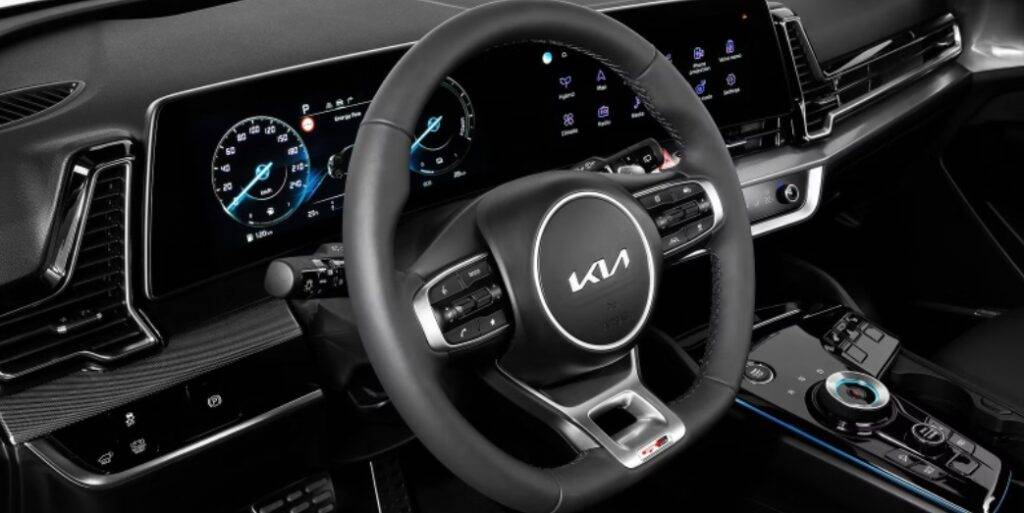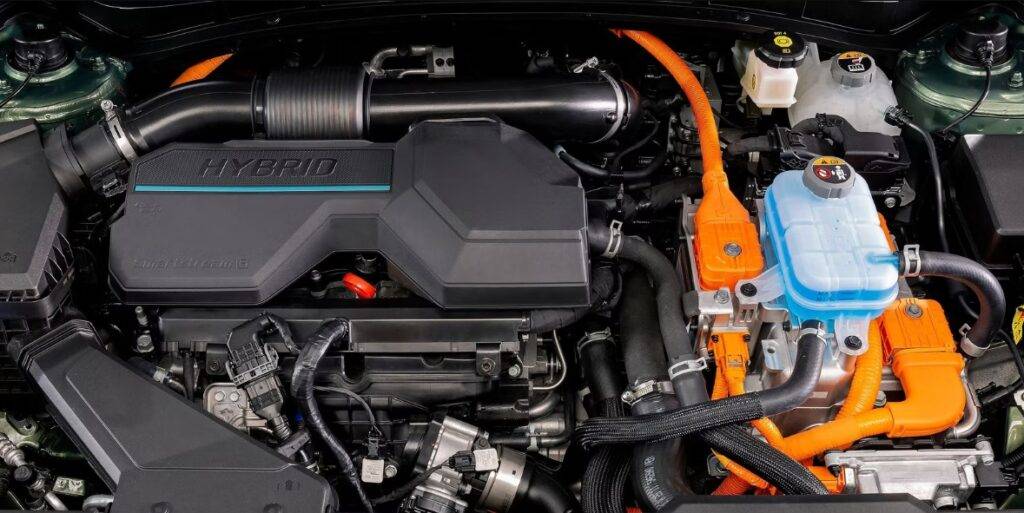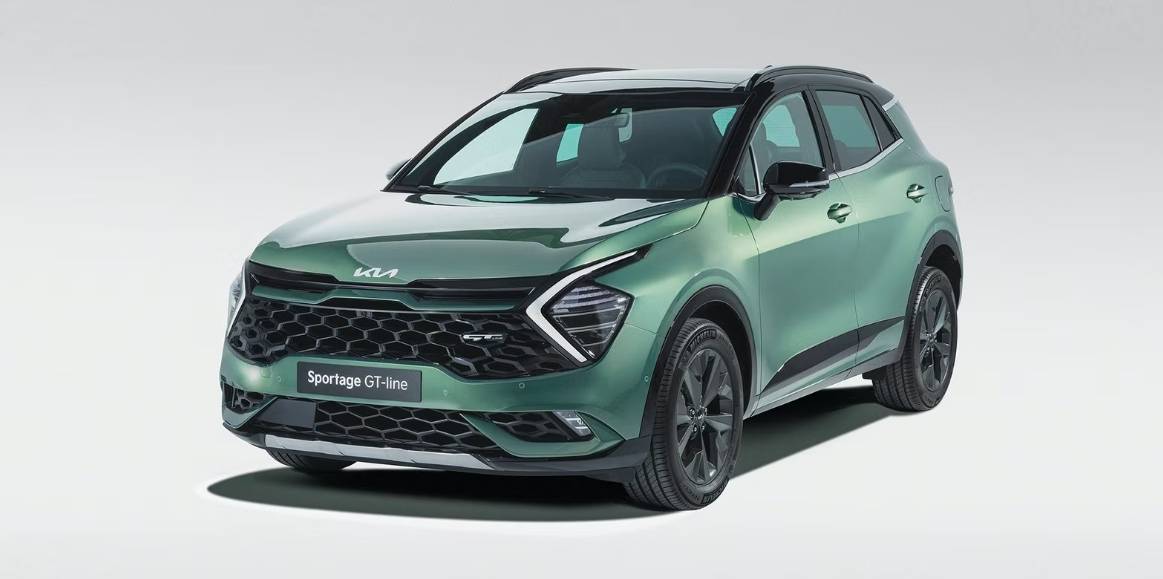The fifth-generation KIA Sportage is a mid-size SUV with different powertrains. The traction can be integral in the most powerful versions. It has a large trunk.
The KIA Sportage is a 4.52-meter-long 5-door, 5-seater midsize SUV that was presented in September 2021, although KIA did not accept reservations until November of the same year. This is the fifth generation of the model, which replaces the one launched in 2016 and updated in 2018. It is available with different propulsion systems and different power levels: diesel (115 hp or 136 hp with light hybridization), gasoline (150 or 180 hp with light hybridization), conventional hybrid (230 hp) or plug-in hybrid (265 hp). Depending on the engine, it may or may not have all-wheel drive. Basic versions have front-wheel drive.
It is the main alternative to the Hyundai Tucson, with which it shares a platform (called N3) and most of the mechanical elements. However, it also competes in its market segment with products such as the SEAT Ateca, the Peugeot 3008, the Ford Kuga or the Nissan Qashqai, among others. All of them are slightly shorter except for the Kuga, which is considerably larger. Only the Peugeot and the Ford have a plug-in hybrid version.
How much does the KIA Sportage cost?
The price of the KIA Sportage is €29,875 as a starting point, although at carwow it enjoys an average saving of €5,000 compared to the list price. Here is a list of the best carwow offers for the KIA Sportage.

Space
The cabin of the KIA Sportage is more spacious and brighter than that of most of its rivals. It is wide enough to accommodate four adults comfortably and has very generous legroom for rear occupants compared to the average in its category. The height of the cabin is normal and somewhat low if the model is equipped with a panoramic roof. In addition, the backrests of the rear seats can be adjusted in inclination. The center seat seat belt is on the roof.
Visibility is very good from any angle and in almost any direction. Access to the passenger compartment is comfortable from any door and the driving position is completely customizable based on the size and preferences of the user through the multiple adjustments of the seat and steering wheel. KIA says the new Sportage outperforms its previous generation in virtually every interior dimension, making it even more of a car for midsize families.
Trunk
Although the KIA Sportage 2022 is only available with five seats, the boot capacity varies depending on the version. KIA has communicated the volume of each version: from 540 to 591 litres. The location of the batteries in the hybrid versions does not have much effect on the space allocated to cargo, which is affected in a similar proportion to that of the Hyundai Tucson, whose versions have between 546 and 620 liters, since both cars share the same platform.
In combination with the gasoline engine without light hybridization, a minimum volume of 591 liters has been announced, expandable to 1,780 if the backrests of the second row of seats are folded down, leaving an almost flat surface. For reference, a Volkswagen Tiguan has a minimum capacity of 520 litres. The seven-seater variant, called the Tiguan AllSpace, has more boot capacity (up to 700 liters with two rows of seats available). Thus, the Sportage has one of the largest trunks relative to its size.
Finish quality
The KIA Sportage has a quality finish above the average in its market segment. The Korean brand has not only carried out a complete redesign of the cabin compared to the 2016 model, but has also worked to increase the perception of its quality. The progress with respect to the previous Sportage is enormous and its appearance is much more modern.
In the best-equipped versions of the model range, the materials used look great in relation to the price of the vehicle, so the feeling between what you pay for and what you get is sublime. In addition, the ornamentation of the various interior elements, the door trims and the roof or dashboard linings show to be well built and have good adjustments.
Combined with the GT-Line trim, which is the only trim we’ve been able to test, the Sportage gets leather upholstery, a flattened, leatherette-wrapped steering wheel with aluminum inserts, suede door panels and decorative trim. in the doors that simulate aluminium, a material from which the door handles and pedals seem to be made.
We don’t like the abuse of piano-black-finish plastic that shows up on the underside of the center console. This defect is compensated thanks to a very high ride quality supported by a high, although not outstanding, acoustic insulation, and a set of screens with good resolution and great resistance to reflections.
Multimedia
On the dashboard there are two screens, each 12.3 inches, integrated under the same glass with a certain curvature, which causes the most central one, responsible for displaying the multimedia functions, to be slightly oriented towards the driver. The other acts as an instrument panel. This resource of placing two equal screens, one next to the other, has been used by many other manufacturers before KIA. The infotainment interface is identical to that of the KIA Sorento and similar to that of the Hyundai Tucson. It is compatible with Android Auto and Apple CarPlay via wireless connection like most new models in this category.
KIA has not renounced, as it happens in the products of other manufacturers, all the physical buttons. For example, it has left a series of controls using keys and wheels in the lower part of the center console that is complemented by a touch panel from which the passenger compartment air conditioning system or direct access to infotainment is operated. The gear lever has been replaced with a round gear selector that has no physical connection to the vehicle’s transmission. It is located at the height of the seats, in the lowest area of the console, so that its handling is as comfortable and practical as possible.
There is an optional sound system, depending on the version, which is signed by Harman Kardon. Induction recharging for mobile phones is also offered in the front seats and controls for air conditioning in the rear, in addition to several USB sockets accessible from all seats.

Engine
The KIA Sportage is available with versions similar to those offered by Hyundai for the Tucson: 115 or 136 hp diesel, 150 or 180 hp gasoline, 230 hp non-plug-in hybrid and 265 hp plug-in hybrid. All thermal engines have 1.6 liters of displacement with turbo and some may have microhybridization, which carries the DGT ECO label.
The two less potent versions are available without light hybridization and are therefore labeled DGT C. Those of 136, 150 and 180 CV, with the denomination MHEV (light hybridization), have the help of a small electric motor. Details are in the attached table below.
The hybrid version (HEV) with a combined power of 230 hp has a 1.5 kWh battery. Its propulsion system consists of two engines: the 1.6 petrol with 180 hp and the other electric with 60 hp (the sum of both powers is not arithmetic, since both engines do not deliver their maximum power at the same time). The 265 hp plug-in hybrid (PHEV) has the same gasoline engine plus a 91 hp electric motor. In this case, the battery is 13.8 kWh (estimated electric range of 60 km). The first one has the ECO label. The second, the ZERO.
The Sportage can have front or all-wheel drive depending on the version. Not all combinations are possible: in the 136 hp diesel and in the non-plug-in hybrid, four-wheel drive is optional. The 180 hp petrol and the plug-in hybrid can only be ordered in a 4×4 configuration. The rest have front-wheel drive.
The 6-speed manual gearbox is available in the 150 hp version with or without microhybridization and in the 115 hp diesel. The rest of the versions have an automatic transmission, which can be of two types: dual-clutch in the intermediate versions and torque converter in the two most powerful Sportages (the 230 hybrid and the 265 hp plug-in).
KIA Sportage finishes
- KIA SportageConcept
- KIA Sportage Drive
- KIA Sportage Tech
- KIA Sportage GT-Line
KIA has organized the range of the new Sportage in four closed finishes (Concept, Drive, Tech and GT-Line) with two optional packages (Design and Luxury). In the best of cases, it can be equipped with electronically controlled hydraulic shock absorbers, a Terrain Mode system that adapts the operation of some mechanical components to drive off-road or on surfaces with low grip (4×4 versions), a panoramic glass roof opening, a set of DriveWise driving aids, full-LED lighting, two-tone body paint, heated and ventilated front seats, a heated steering wheel, headrest hangers and all the multimedia equipment described in the corresponding section. In our configurator, you can see all the details related to the equipment of this model.
Driving
The KIA Sportage is a very dynamically balanced SUV despite its family concept and orientation towards comfort, so that it can successfully meet the needs of a customer who wants a spacious car, with five seats and a large trunk, but with a moderate size, a high technological endowment, several propulsion systems and a chassis that allows you to enjoy driving despite the limitations of an SUV in this regard. What’s more, we are convinced that it meets the expectations of the most demanding buyers, accustomed to superior quality and performance, since both KIA and its Sportage have become a brand and a winning product for traditional consumers of a higher category and who appreciate a good vehicle in every sense of the term.
The version we tested was a non-plug-in hybrid with front-wheel drive, 230 hp, GT-Line finish and Continental EcoContact 6 size 235/55 R18 tires on both axles (they offer good grip). Overall, we found it to be a nice car to drive. An adaptive suspension with electronically controlled hydraulic shock absorbers has been chosen which, in any case, is very comfortable and filters out irregularities in the terrain effectively. On the other hand, it seems that the installed springs do not support the body as well as they should during rapid support changes, which results in excessive body roll during sporty driving.
Even so, corners can be weaved faster than comparable cars without feeling out of control when transferring weight through the brakes or steering, which has a smooth feel but not as artificial as most of its competitors and achieves communicate what happens in the front train. Given the purpose of the Sportage, it gives the impression that it is a very neutral and versatile SUV, since it grants relatively wide possibilities of use. Despite this and the fact that its weight distribution is almost optimal, its high center of gravity translates into some dynamic limitations typical of this class. The sense of security that it conveys is considerable and is complemented by a very wide range of assistants, very intrusive but disconnectable if necessary. Not too much understeer is accused despite the engine scheme, even when that effect is intentionally sought. His level of maneuverability is normal.
The hybrid version not only has plenty of performance for all circumstances based on the focus of this vehicle, but it is interesting both for consumption and purchase price. The differences between the Eco and Sport driving modes (the only ones that this particular model has) have been almost negligible in practice. It is noted that the accelerator becomes more responsive, that the steering subtly stiffens and that the automatic transmission selects a shorter gear with the sporty profile, without more noticeable changes apart from the graphic modifications suffered by the instrument panel.
Torque converter transitions are as smooth and unobtrusive as those that occur when going from electric to hybrid operation (knowing when the gas engine fires is difficult if you’re not very attentive). Now, in the case of the transmission, they are slow changes when all the power is required (it has a hard time lowering the ratio). To make up for this fault, KIA has put chrome paddles behind the steering wheel with which you can select the optimal gear before, for example, starting an overtaking (they don’t work quickly either).
In EV mode, you cannot travel more than 3 or 4 km, since the battery, located under the second row of seats, is very small (1.5 kWh). It is also not possible to receive a forceful response from the electric motor, although it is immediate, since it has little power (60 hp). In other words, this operation is only suitable for driving that is excessively relaxed and focused on not pressing the right pedal more than is fair and necessary. To move the car with agility, it is necessary to make use of the thermal propellant (which by itself only yields 180 CV). In exchange for this inconvenience, fuel consumption is moderate and the DGT ECO label is obtained with all its advantages.
The brakes, whose stopping power is high, are designed to recover energy during deceleration. They can tire very easily if their performance is extreme, since the electronic aids also make constant use of them when cornering at the limit of adherence. Unlike other hybrid cars, the feel of the pedal that drives them isn’t unpleasant or complicated to modulate, although it has a longer travel than usual and feels more spongy. The GT-Line finish does not imply an improvement in this aspect.
The degree of ergonomics of the driving position is high thanks to firm but comfortable seats and the ease of use of the multimedia system and climate controls, very successful. KIA has equipped the Sportage with a touch display that it calls Multi-Mode, which can vary its appearance from a direct access panel for several of the infotainment options offered by the vehicle to an operating control for the climate control. The wheels located at both ends of this element also change their function and serve as a haptic reference, allowing the device to be used without taking your eyes off the road. Of course, we have noticed that the screens get very hot after a few hours on.
Consumption
Officially, the consumption of the Sportage with non-plug-in hybrid propulsion system and front-wheel drive (version that we have been able to test) is 5.6 l/100 km according to the combined cycle approved by the WLTP procedure. This consumption can really be achieved if we move only through urban and semi-urban environments, since as soon as the car leaves a motorway and maintains a speed of 120 km/h for many kilometers, it does not drop below approximately 7.5 l/100 km. . An objective average mixing city and highway use could be between 6 and 7 l/100 km, depending on our driving style. The rest of the versions approve a fuel consumption between 1.1 l/100 km and 7.1 l/100 km.
Driving aids
KIA includes driver aids (ADAS) in the suite of DriveWise assistants, which includes:
- Сrossing assistant
- Highway Driving Assist (HDA)
- Navigation-based adaptive cruise control
- Automatic lane centering
- Signal recognition with speed adjustment
- Blind spot monitoring in the instrument cluster
- Rear Cross Traffic Alert
- Autonomous emergency braking with cyclist and pedestrian detection
- smart remote parking
- Perimetric vision (360 degrees) through external cameras
- Traction and stability control
Also, in terms of passive safety, this model has eight airbags (driver, passenger, side curtain, side hip and central) and a monocoque-type structure that, according to KIA, is lighter and more rigid than in the previous Sportage.

